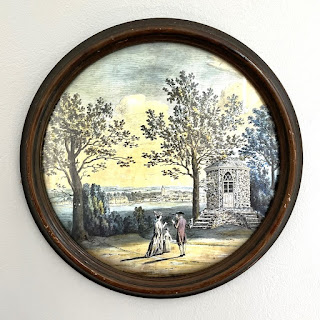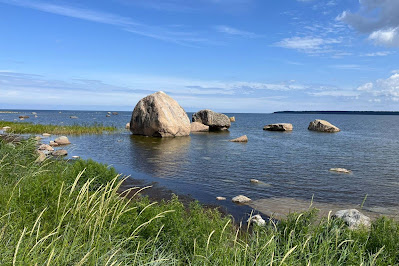I recently read this lovely new book about the glacier pictures of Wilhelmina Barns-Graham. I've written about these before: the 1949 trip to Grindelwald features in the new Mark Cousins film I wrote about last October (he has an essay in The Glaciers); prior to that, in 2018, I went to see some of the paintings and sketches in an exhibition at the Jerwood Gallery in Hastings. Here, as a special treat for the geographers amongst you, I am going to highlight the glacial features identified by Peter Nienow in his essay 'Art and Ice Loss: A Glaciologist's look at Wilhelmina Barns-Graham's Glaciers.'
Blue Ice
'Dense, clean glacier light absorbs the long (red) wavelengths of light while at the same time scattering the the short wave blue-light.' You can see this in her most famous glacier painting, the Tate's Glacier Crystal, Grindelwald (1950). Nienow wonders whether Barns-Graham visited one of those tourist glacier tunnels where you can enter and marvel at this blue light. I imagine none of these will be left soon, but we visited the one they have at Titlis in Switzerland back in 2017.
Moulins and Dolines
Many of her paintings have 'blue circular swirls and holes in the ice, clearly visible in for example Glacier Vortex (1950', the image you can see above. Meltwater ponds develop at the start of summer and then drain away leaving the depressions in ice called dolines. Water flowing down through the glacier creates vertical moulins and Nienow tells us that 'in the Alps, I have plumbed these precipitous pipes.' He mentions the unnervingly large examples they have on the Greenland glacier, which reminded my of the chapter in Robert MacFarlane's Underland where he is let down into one on a rope and balances himself on a spear-like blade of ice before being pulled to safety.
Crevasses
The much-produced photograph of Barns-Graham and the Brotherton family on holiday in May 1949 climbing the Upper Grindelwald Glacier shows them threading their way upwards joined by a rope, with crevasses visible on either side. The two Brotherton boys look as if they are still wearing their school uniform of shorts and long socks and their father has a tweed jacket on. Crevasses feature in the dramatic paintings of Romantic artists like Thomas Fearnley, but Barns-Graham wasn't interested in panoramic views. She was more concerned with geometry and form, and several of her 1949 glacier studies show patterns of crevasses separating irregular blocks of ice.
Superglacial debris
Her paintings are dominated by greys, blues and white but there are sometimes patches of brown which represent the colours of rock that has fallen onto the surface of the glacier. Nienow reproduces Glacier, Rock Forms (1950 which has 'possible evidence of iron-oxide-stained rock debris' in it. Some of these fallen boulders eventually end up perched on pedestals of ice like natural sculptures, resembling the work of her contemporaries in St. Ives.
Foliation
Foliation is the process by which fine lines in the ice are created, marking summer periods when dust, pollen and insects collect on the surface of the snow. Once these layers become ice and start moving downhill, they can get folded and fractured, creating patterns that Barns-Graham reproduced in sketches like End of the Glacier, Upper Grindelwald. I'm sure she would have loved the glacier we visited in Iceland, where the ice was covered in black volcanic dust.
Peter Nienow's essay ends on an elegiac note with statistics on glacial retreat in Switzerland. He says they lost 10% of their ice volume between 2021 and 2023. Wow. That is such a short period - it only seems like yesterday I was reporting here on our visit to the Swiss mountains in 2017. Sadly, nobody now can see what Wilhelmina Barns-Graham saw. 'The stunning ice fall that she explored and drew inspiration from as it tumbled down towards the outskirts of Grindelwald village is no more.'

































